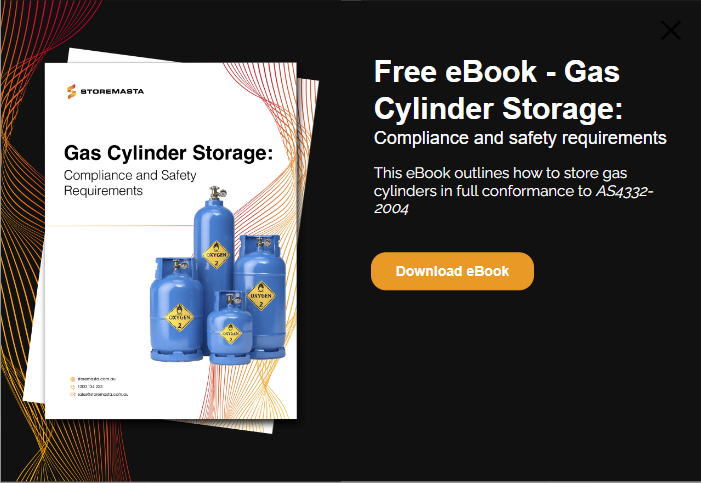Acetylene and oxygen gases are frequently used for welding and cutting applications at workplaces all over Australia. In many instances the gases are combined to create a very high temperature for the torch flame. This blog is NOT a list of oxyacetylene welding instructions, it’s about when the welding work is done for the day — and the critical importance of disconnecting both acetylene and oxygen cylinders from the welding apparatus and then storing them correctly.
What are acetylene and oxygen cylinders?
Pure oxygen is used in gas welding, cutting, soldering, and brazing applications. Although oxygen itself will not burn, it vigorously accelerates the combustion of other flammable gases such as acetylene.
WARNING: Oxygen is a Class 2.2/5.1 non-flammable, oxidising gas and may cause or intensify a fire, as well as explode if the cylinder is heated. Class 2.2 gases must be stored at least 3 metres away from Class 2.1 flammable gases.
Acetylene is a volatile fuel gas with a wide range of industrial applications including welding and brazing; wood-ageing and carbon coating; flame heating / gouging / hardening / cleaning; thermal spraying; and texturing.
Acetylene is never used in its pure state and comes in special cylinders containing a porous mass and a mixture of the gas dissolved in a solvent (usually acetone). These special cylinders are designed to slow down decomposition: a dangerous chemical reaction that creates intense heat and explosions.
WARNING: Acetylene is a Class 2.1 flammable gas and can react dangerously with oxidising agents, so it must be separated from Class 2.2/5.1 non-flammable, oxidising gases by at least 3 metres. Acetylene may explode if heated.
Risks and hazards of acetylene and oxygen cylinders
There are a multitude of hazards associated with acetylene and oxygen cylinders. Whether they're used on their own or in conjunction for a welding application, these dangerous goods can pose risk to staff, property and the wider community. We'll look at some of these risks in the next section of our post.
Acetylene cylinders
Acetylene cylinders are unique because the flammable gas is so volatile it must be dissolved in a solvent and stored with a porous mass to keep it stable. Their main risk is decomposition which generates heat and causes fires and explosions.
Decomposition can be caused by:
- Exposure to heat (direct sunlight, industrial plant and machinery, hot works)
- Reaction to incompatible substances like copper and brass
- Flashbacks from welding and hot work operations
- Movement and separation of the acetone, the gas, and the porous mass inside the cylinders
- Contact with sparks, static electricity or other ignition sources
- Rapid and uncontrolled release of the gas
IMPORTANT: Many times decomposition occurs because the cylinders are dropped, impacted, or handled roughly. Always keep acetylene cylinders restrained with a safety strap or chain.
Oxygen cylinders
When oxygen levels in the atmosphere are higher than 21%, this is known as an oxygen enriched environment. Cylinder leaks or breaches can quickly raise the oxygen levels in a room or confined space leading to a fire or explosion.
An oxygen enriched atmosphere can be caused by:
- Gas leaks from damaged hoses, worn and damaged valves, loose connections
- Leaving valves open when the cylinder is in storage
- Substituting oxygen for compressed air or other gases
- Uncontrolled release of gas after a cylinder is dropped or impacted
- Trying to add oxygen to confined spaces
- Misuse and pranks
Oxygen cylinders can explode when in contact with incompatible substances like oil, grease, certain plastics and metals then creating fires and explosions. Heat can also cause the gas to expand and explode.
Storing acetylene and oxygen cylinders
According to Section 4.4 of AS4332-2004 - The storage and handling of gases in cylinders, Class 2.1 flammable gases and Class 2.2 non-flammable, oxidising gases must be stored at least 3 metres apart. This means that if oxygen and acetylene are combined for welding, after the work is finished, the cylinders must be disconnected and returned to the gas cylinder store. They cannot remain together on the work trolley.
In the cylinder store, the acetylene and oxygen gas bottles must then be segregated into their own hazard classes, at least 3 meters away from each other. If you are restricted by area size, screen walls can be erected inside the cylinder stores to segregate Class 2.1 and Class 2.2 gases. This wall must be at least 1 meter higher than the tallest cylinder, made from non-combustible material, and be impervious to gas vapors.
The Australian Standard also requires that the total quantity of cylinders onsite (in use, as stand-by or empty) must be minimised as far as possible. In the USA it’s limited to approximately one day’s consumption, but in Australia it really comes down to business usage, supplier availability and budget constraints.
NOTE: Although outside the scope of this blog, acetylene and oxygen gases should also be stored away from Class 2.3 toxic gases.
Storing Acetylene and Oxygen
If you use and store acetylene and oxygen gas - as well as other compressed gases in cylinders, we encourage you to download our free eBook Gas cylinder storage: Compliance and storage requirements. We’ll introduce you to the STOREMASTA risk management methodology Identify - Assess - Control - Sustain and detail how to control the risks associated with storing gas cylinders at your workplace.
Joining the team as a Dangerous Goods Storage Consultant, Melissa Hampton became Storemasta's Marketing Manager in late 2021. With extensive knowledge and experience in chemical compliance, Melissa is responsible for leading the Marketing team and helping shape their marketing strategy. In her spare time, you can find Melissa hiking, swimming and enjoying the great outdoors in beautiful north-west Tasmania.
